
How to Write a Discursive Essay: Awesome Guide and Template

Interesting fact: Did you know that the term "discursive" is derived from the Latin word "discursus," which means to run about or to traverse? This reflects the nature of a discursive essay, as it involves exploring various perspectives, moving through different points of view, and presenting a comprehensive discussion on a given topic.
In this article, you will find out about a discursive essay definition, learn the difference between a discourse and an argumentative essay, gain practical how-to tips, and check out a discursive essay example.
What Is a Discursive Essay
A discursive essay definition is a type of formal writing that presents a balanced analysis of a particular topic. Unlike an argumentative essay, which takes a firm stance on a single perspective and seeks to persuade the reader to adopt that viewpoint, a discursive essay explores multiple sides of an issue.
The goal of a discursive essay is to provide a comprehensive overview of the subject, presenting different arguments, counterarguments, and perspectives in a structured and organized manner.
This type of essay encourages critical thinking and reasoned discourse. It typically includes an introduction that outlines the topic and sets the stage for the discussion, followed by a series of body paragraphs that delve into various aspects of the issue. The essay may also address counterarguments and opposing viewpoints.
Finally, a discursive essay concludes by summarizing the key points and often leaves room for the reader to form their own informed opinion on the matter. This form of writing is commonly assigned in academic settings, allowing students to demonstrate their ability to analyze complex topics and present a well-reasoned exploration of diverse viewpoints. In case you find this type of composition too difficult, just say, ‘ write my paper ,’ and professional writers will take care of it.
Ready to Transform Your Essays?
From discursive writing to academic triumphs, let your words soar with our essay writing service!
Difference Between a Discursive Essay and an Argumentative
The main difference between discursive essays and argumentative lies in their overall purpose and approach to presenting information.
- Discursive: The primary purpose of a discursive essay is to explore and discuss various perspectives on a given topic. How to write a discursive essay is about providing a comprehensive overview of the subject matter by presenting different arguments, opinions, and viewpoints without necessarily advocating for a specific stance.
- Argumentative: In contrast, an argumentative essay is designed to persuade the reader to adopt a particular viewpoint or take a specific action. It presents a clear and focused argument in favor of the writer's position, often addressing and refuting opposing views.
Tone and Language:
- Discursive: The tone of a discursive essay is generally more balanced and objective. It allows for a more open exploration of ideas, and the language used is often neutral and formal.
- Argumentative: An argumentative essay tends to have a more assertive tone. The language is focused on presenting a compelling case from the writer's perspective, and there may be a sense of conviction in the presentation of evidence and reasoning.
- Discursive Essay: A discursive essay typically follows a more flexible structure. It may present multiple points of view in separate sections, allowing for a free-flowing exploration of the topic.
- Argumentative Essay: When learning how to write an argumentative essay, students usually follow a more rigid structure, with a clear introduction, thesis statement, body paragraphs that present evidence and arguments, and a conclusion that reinforces the writer's stance.
Conclusion:
- Discursive Essay: The conclusion of a discursive essay often summarizes the main points discussed and may leave room for the reader to form their own opinion on the matter.
- Argumentative Essay: The conclusion of an argumentative essay reinforces the writer's position and may include a call to action or a clear statement of the desired outcome.
While both types of essays involve critical thinking and analysis, the key distinction lies in their ultimate goals and how they approach the presentation of information.
Types of Discursive Essay
Before writing a discursive essay, keep in mind that they can be categorized into different types based on their specific purposes and structures. Here are some common types of discursive essays:
.webp)
Opinion Essays:
- Purpose: Expressing and supporting personal opinions on a given topic.
- Structure: The essay presents the writer's viewpoint and provides supporting evidence, examples, and arguments. It may also address counterarguments to strengthen the overall discussion.
Problem-Solution Essays:
- Purpose: Identifying a specific problem and proposing effective solutions.
- Structure: The essay introduces the problem, discusses its causes and effects, and presents possible solutions. It often concludes with a recommendation or call to action.
Compare and Contrast Essays:
- Purpose: Analyzing similarities and differences between two or more perspectives, ideas, or approaches.
- Structure: The essay outlines the key points of each perspective, highlighting similarities and differences. A balanced analysis is provided to give the reader a comprehensive understanding.
Cause and Effect Essays:
- Purpose: Exploring the causes and effects of a particular phenomenon or issue.
- Structure: The essay identifies the primary causes and examines their effects or vice versa. It may delve into the chain of events and their implications.
Argumentative Essays:
- Purpose: Presenting a strong argument in favor of a specific viewpoint.
- Structure: The essay establishes a clear thesis statement, provides evidence and reasoning to support the argument, and addresses opposing views. It aims to persuade the reader to adopt the writer's perspective.
Pro-Con Essays:
- Purpose: Evaluating the pros and cons of a given issue.
- Structure: The essay presents the positive aspects (pros) and negative aspects (cons) of the topic. It aims to provide a balanced assessment and may conclude with a recommendation or a summary of the most compelling points.
Exploratory Essays:
- Purpose: Investigating and discussing a topic without necessarily advocating for a specific position.
- Structure: The essay explores various aspects of the topic, presenting different perspectives and allowing the reader to form their own conclusions. It often reflects a process of inquiry and discovery.
These types of discursive essays offer different approaches to presenting information, and the choice of type depends on the specific goals of the essay and the preferences of the writer.
How to Write a Discursive Essay
Unlike other forms of essay writing, a discursive essay demands a unique set of skills, inviting writers to navigate through diverse perspectives, present contrasting viewpoints, and weave a tapestry of balanced arguments.
You can order custom essay right now to save time to get ready to delve into the art of crafting a compelling discursive essay, unraveling the intricacies of structure, language, and critical analysis. Whether you're a seasoned essayist or a novice in the realm of formal writing, this exploration promises to equip you with the tools needed to articulate your thoughts effectively and engage your audience in thoughtful discourse.
.webp)
Discursive Essay Format
The format of a discursive essay plays a crucial role in ensuring a clear, well-organized, and persuasive presentation of multiple perspectives on a given topic. Here is a typical discursive essay structure:
1. Introduction:
- Hook: Begin with a captivating hook or attention-grabbing statement to engage the reader's interest.
- Contextualization: Provide a brief overview of the topic and its relevance, setting the stage for the discussion.
- Thesis Statement: Clearly state the main argument or the purpose of the essay. In a discursive essay, the thesis often reflects the idea that the essay will explore multiple viewpoints without necessarily taking a firm stance.
2. Body Paragraphs:
- Topic Sentences: Start each body paragraph with a clear topic sentence that introduces the main point or argument.
- Presentation of Arguments: Devote individual paragraphs to different aspects of the topic, presenting various arguments, perspectives, or evidence. Ensure a logical flow between paragraphs.
- Address Counterarguments: Acknowledge and address opposing viewpoints to strengthen the overall credibility of your essay.
- Supporting Evidence: Provide examples, statistics, quotations, or other forms of evidence to bolster each argument.
3. Transitions:
- Logical Transitions: Use transitional phrases and words to ensure a smooth and logical flow between paragraphs and ideas. This helps readers follow your line of reasoning.
4. Conclusion:
- Restate Thesis: Summarize the main argument or purpose of the essay without introducing new information.
- Brief Recap: Provide a concise recap of the key points discussed in the body paragraphs.
- Closing Thoughts: Offer some closing thoughts or reflections on the significance of the topic. You may also leave room for the reader to consider their own stance.
5. Language and Style:
- Formal Tone: Maintain a formal and objective tone throughout the essay.
- Clarity and Coherence: Ensure that your ideas are presented clearly and that there is coherence in your argumentation.
- Varied Sentence Structure: Use a variety of sentence structures to enhance readability and engagement.
6. References (if applicable):
- Citations: If you use external sources, cite them appropriately according to the citation style required (e.g., APA, MLA).
Remember, flexibility exists within this format, and the specifics may vary based on the assignment requirements or personal writing preferences. Tailor the structure to suit the demands of your discourse and the expectations of your audience.
Introduction
A discursive essay introduction serves as the gateway to a thought-provoking exploration of diverse perspectives on a given topic. Here's how to structure an effective discursive essay introduction:
- Begin with a compelling hook that captures the reader's attention. This could be a striking statistic, a thought-provoking quote, a relevant anecdote, or a rhetorical question.
- Offer a brief context or background information about the topic. This helps orient the reader and sets the stage for the discussion to follow.
- Clearly state the purpose of the essay. This often involves indicating that the essay will explore various perspectives on the topic without necessarily advocating for a specific stance.
- Provide a brief overview of the different aspects or arguments that will be explored in the essay.
- Conclude the introduction with a clear and concise thesis statement.
Remember that besides writing compositions, you still have to do math homework , which is something we can help you with right now!
Writing a discursive essay involves crafting the body of your discursive essay. The number of paragraphs in the body should correspond to the arguments presented, with an additional paragraph dedicated to the opposing viewpoint if you choose to disclose both sides of the argument. If you opt for this approach, alternate the order of the body paragraphs—supporting arguments followed by counterarguments.
Each body paragraph in your discursive essay should focus on a distinct idea. Begin the paragraph with the main idea, provide a concise summary of the argument, and incorporate supporting evidence from reputable sources.
In the concluding paragraph of the body, present potential opposing arguments and counter them. Approach this section as if engaging in a debate, strategically dismantling opposing viewpoints.
While composing the body of a discursive essay, maintain a cohesive narrative. Although individual paragraphs address different arguments, refrain from titling each paragraph—aim for a seamless flow throughout the essay. Express your personal opinions exclusively in the conclusion.
Key guidelines for writing the body of a discursive essay:
- Remain Unbiased: Prioritize objectivity. Evaluate all facets of the issue, leaving personal sentiments aside.
- Build Your Argumentation: If you have multiple arguments supporting your viewpoint, present them in separate, well-structured paragraphs. Provide supporting evidence to enhance clarity and credibility.
- Use an Alternate Writing Style: Present opposing viewpoints in an alternating manner. This means that if the first paragraph supports the main argument, the second should present an opposing perspective. This method enhances clarity and research depth and ensures neutrality.
- Include Topic Sentences and Evidence: Commence each paragraph with a topic sentence summarizing the argument. This aids reader comprehension. Substantiate your claims with evidence, reinforcing the credibility of your discourse.
By adhering to these principles, you can construct a coherent and well-supported body for your discursive essay.
Conclusion
Writing an effective conclusion is crucial to leaving a lasting impression on your reader. Here are some tips to guide you in crafting a compelling and impactful conclusion:
- Begin your conclusion by summarizing the key points discussed in the body of the essay.
- Remind the reader of your thesis statement, emphasizing the primary purpose of your discursive essay.
- Address the broader significance or implications of the topic.
- Explain why the issue is relevant and underscore the importance of considering multiple perspectives in understanding its complexity.
- Reiterate the balanced nature of your essay. Emphasize that you have explored various viewpoints and arguments without necessarily taking a firm stance.
- Reinforce the idea that your goal was to present a comprehensive analysis.
- If applicable, suggest possible recommendations or solutions based on the insights gained from the essay.
- Encourage the reader to reflect on the topic independently.
- Pose open-ended questions or invite them to consider the implications of the arguments presented.
- Resist the temptation to introduce new information or arguments in the conclusion.
- Keep the tone of your conclusion professional and thoughtful.
- Conclude your essay with a strong, memorable closing statement.
- Carefully review your conclusion to ensure clarity and coherence. Edit for grammar, punctuation, and overall writing quality to present a polished final product.
By incorporating these tips into your discursive essay conclusion, you can effectively summarize your arguments, leave a lasting impression, and prompt thoughtful reflection from your readers. Consider using our term paper writing service if you have to deal with a larger assignment that requires more time and effort.
Yays and Nays of Writing Discourse Essays
In learning how to write a discursive essay, certain do's and don'ts serve as guiding principles throughout the writing process. By adhering to these guidelines, writers can navigate the complexities of presenting arguments, counterarguments, and nuanced analyses, ensuring the essay resonates with clarity and persuasiveness.
- Conduct thorough research on the topic to ensure a well-informed discussion.
- Present multiple perspectives on the issue, exploring various arguments and viewpoints.
- Maintain a balanced and neutral tone. Present arguments objectively without expressing personal bias.
- Structure your essay logically with a clear introduction, body, and conclusion. Use paragraphs to organize your ideas effectively.
- Topic Sentences:
- Include clear topic sentences at the beginning of each paragraph to guide the reader through your arguments.
- Support your arguments with credible evidence from reputable sources to enhance the credibility of your essay.
- Use transitional words and phrases to ensure a smooth flow between paragraphs and ideas.
- Engage in critical analysis. Evaluate the strengths and weaknesses of different arguments and viewpoints.
- Recap key points in the conclusion, summarizing the main arguments and perspectives discussed in the essay.
- Carefully proofread your essay to correct any grammar, spelling, or punctuation errors.
- Don't express personal opinions in the body of the essay. Save personal commentary for the conclusion.
- Don't introduce new information or arguments in the conclusion. This section should summarize and reflect on existing content.
- Don't use overly emotional or subjective language. Maintain a professional and objective tone throughout.
- Don't rely on personal opinions without sufficient research. Ensure that your arguments are supported by credible evidence.
- Don't have an ambiguous or unclear thesis statement. Clearly state the purpose of your essay in the introduction.
- Don't ignore counterarguments. Acknowledge and address opposing viewpoints to strengthen your overall argument.
- Don't use overly complex language if it doesn't add to the clarity of your arguments. Strive for clarity and simplicity in your writing.
- Don't present ideas in a disorganized manner. Ensure that there is a logical flow between paragraphs and ideas.
- Don't excessively repeat the same points. Present a variety of arguments and perspectives to keep the essay engaging.
- Don't ignore the guidelines provided for the essay assignment. Follow any specific instructions or requirements given by your instructor or institution.
Feeling exhausted and overwhelmed with all this new information? Don't worry! Buy an essay paper of any type that will be prepared for you individually based on all your instructions.
Discursive Essay Examples
Discursive essay topics.
Writing a discursive essay on a compelling topic holds immense importance as it allows individuals to engage in a nuanced exploration of diverse perspectives. A well-chosen subject encourages critical thinking and deepens one's understanding of complex issues, fostering intellectual growth.
The process of exploring a good topic enhances research skills as writers delve into varied viewpoints and gather evidence to support their arguments. Moreover, such essays contribute to the broader academic discourse, encouraging readers to contemplate different facets of a subject and form informed opinions.
- The Impact of Artificial Intelligence on Employment.
- Should Social Media Platforms Regulate Content for Misinformation?
- Exploring the Ethics of Cloning in Contemporary Science.
- Universal Basic Income: A Solution for Economic Inequality?
- The Role of Technology in Shaping Modern Education.
- Nuclear Energy: Sustainable Solution or Environmental Risk?
- The Effects of Video Games on Adolescent Behavior.
- Cybersecurity Threats in the Digital Age: Balancing Privacy and Security.
- Debunking Common Myths Surrounding Climate Change.
- The Pros and Cons of Genetically Modified Organisms (GMOs).
- Online Education vs. Traditional Classroom Learning.
- The Impact of Social Media Influencers on Consumer Behavior.
- The Ethics of Animal Testing in Medical Research.
- Universal Healthcare: Addressing Gaps in Healthcare Systems.
- The Role of Government in Regulating Cryptocurrencies.
- The Influence of Advertising on Body Image and Self-Esteem.
- Renewable Energy Sources: A Viable Alternative to Fossil Fuels?
- The Implications of Space Exploration on Earth's Resources.
- Is Censorship Justified in the Arts and Entertainment Industry?
- Examining the Impact of Globalization on Cultural Identity.
- The Morality of Capital Punishment in the 21st Century.
- Should Genetic Engineering be Used for Human Enhancement?
- Social Media and Its Influence on Political Discourse.
- Balancing Environmental Conservation with Economic Development.
- The Role of Gender in the Workplace: Achieving Equality.
- Exploring the Impact of Fast Fashion on the Environment.
- The Benefits and Risks of Autonomous Vehicles.
- The Influence of Media on Perceptions of Beauty.
- Legalization of Marijuana: Addressing Medical and Social Implications.
- The Impact of Antibiotic Resistance on Global Health.
- The Pros and Cons of a Cashless Society.
- Exploring the Relationship Between Technology and Mental Health.
- The Role of Government Surveillance in Ensuring National Security.
- Addressing the Digital Divide: Ensuring Access to Technology for All.
- The Impact of Social Media on Political Activism.
- The Ethics of Animal Rights and Welfare.
- Nuclear Disarmament: Necessity or Utopian Ideal?
- The Effects of Income Inequality on Societal Well-being.
- The Role of Education in Combating Systemic Racism.
- The Influence of Pop Culture on Society's Values and Norms.
- Artificial Intelligence and Its Impact on Creative Industries.
- The Pros and Cons of Mandatory Vaccination Policies.
- The Role of Women in Leadership Positions: Breaking the Glass Ceiling.
- Internet Privacy: Balancing Personal Security and Data Collection.
- The Impact of Social Media on Youth Mental Health.
- The Morality of Animal Agriculture and Factory Farming.
- The Rise of Online Learning Platforms: Transforming Education.
- Addressing the Digital Gender Gap in STEM Fields.
- The Impact of Global Tourism on Local Cultures and Environments.
- Exploring the Implications of 3D Printing Technology in Various Industries.
By the way, we have another great collection of narrative essay topics to get your creative juices flowing.
Wrapping Up
Throughout this guide, you have acquired valuable insights into the art of crafting compelling arguments and presenting diverse perspectives. By delving into the nuances of topic selection, structuring, and incorporating evidence, you could hone your critical thinking skills and sharpen your ability to engage in informed discourse.
This guide serves as a roadmap, offering not just a set of rules but a toolkit to empower students in their academic journey. As you embark on future writing endeavors, armed with the knowledge gained here, you can confidently navigate the challenges of constructing well-reasoned, balanced discursive essays that contribute meaningfully to academic discourse and foster a deeper understanding of complex issues. If you want to continue your academic learning journey right now, we suggest that you read about the IEEE format next.
Overwhelmed by Essays?
Let professional writers be your writing wingman. No stress - just success!
Related Articles
.webp)
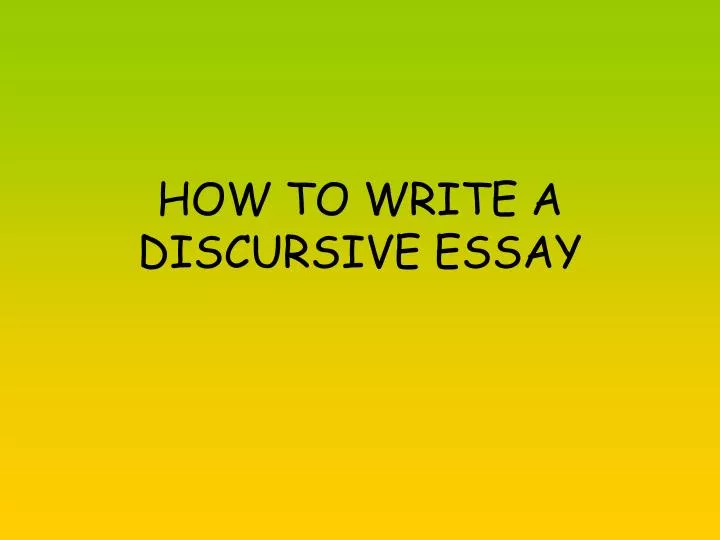
HOW TO WRITE A DISCURSIVE ESSAY
Mar 18, 2019
790 likes | 1.77k Views
HOW TO WRITE A DISCURSIVE ESSAY. PLANNING. Planning is key to a successful essay Always make a list of for and against arguments first. Make sure that you have sufficient arguments for both sides of the point Use evidence to support your point. STRUCTURE. Introduction
Share Presentation
- topic suggest
- topic agree
- topic maintain
- support topic suggest
- outlined previously earlier

Presentation Transcript
PLANNING • Planning is key to a successful essay • Always make a list of for and against arguments first. • Make sure that you have sufficient arguments for both sides of the point • Use evidence to support your point.
STRUCTURE • Introduction • 2. One or two paragraphs arguing your main FOR or AGAINST points and putting forward the counter arguments • 3. One or two paragraphs arguing your secondary FOR or AGAINST points and putting forward your counter arguments • 4. Conclusion You can structure your essay in two ways: 1. Introduction 2. One or two paragraphs arguing all your FOR points 3. One or two paragraphs arguing all your AGAINST points 4. Conclusion
INTRODUCTION • State what you are writing about: • In this essay I will be discussing the issue of……( refer to the essay title) • Give a reason why you are writing about this: • This subject is very topical and affects many people • State what you are going to do: • I will examine arguments for and against this topic and draw a conclusion based on the facts presented.
HOW TO PUT FORWARD YOUR FOR ARGUMENTS • People in favour of + topic argue that • Supporters of + topic believe that • Advocates of + topic maintain that • Campaigners of + topic claim that • Proponents of + topic feel that • Those who support + topic suggest that • Pressure groups in favour of + agree that • Believers in + topic • Followers of + topic • Users of + topic
HOW TO ADD FURTHER INFORMATION TO SUPPORT YOUR ARGUMENT • AND is used when you want to join two similar ideas, some alternatives are: therefore moreover also apart from that as a result accordingly on top of that consequently in addition thus furthermore hence what is more
REFORMULATING YOUR IDEAS • OR is used when you want to put two different ideas together or reformulate what you have stated earlier, some alternatives are: in other words to put it more simply it would be better to say alternativelyto put it straightforwardly
PUTTING FORWARD A CONTRASTING ARGUMENT • BUT appears when you need to contrast one statement with another: However, in contrastnevertheless, on the other hand,nonetheless, despite the fact thatyet, all the same,in spite of that,
HOW TO PUT FORWARD YOUR AGAINST ARGUMENTS • People against + topic argue that • Critics of + topic believe that • Opponents of + topic maintain that • Challengers of + topic claim that • Campaigners against + topic feel that • Those opposed to + topic suggest that • Pressure groups against + topic agree that
HOW TO INTRODUCE EVIDENCE AND EXAMPLES • This clearly demonstrates that... • This illustrates how……………. • There is some/clear evidence that… • There is mounting evidence that… • A recent study found that… • Research tells us that…….
HOW TO EXPLAIN CONSEQUENCES ………………..happened …….. • because of due to • as a result of as a consequence of • on account of in response to • owing to following on from
YOUR CONCLUSION • Sum up your main points • State your point of view • Give your reason for this. • Offer a solution if you have one
EXPRESSING YOUR OPINION IN THE CONCLUSION • I agree/ disagree with the above statement (that...) • In my opinion... • I believe that... • I am in favour of... • I am against the idea of... • It seems to me that... • I sympathise with...
CONCLUSION WORD BANK • To sum up/ altogether • On this basis, I can conclude that... • Given this, it can be concluded that... • Having proved this, I would like to... • In conclusion, I would like to stress that… • All in all, I believe that... • Ultimately,... • Finally I would conclude that… • As outlined previously/earlier • As previously stated • We could conclude that..
- More by User
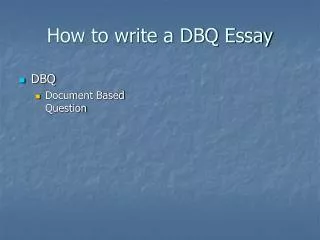
How to write a DBQ Essay
How to write a DBQ Essay. DBQ Document Based Question. Thesis Statements .
554 views • 26 slides
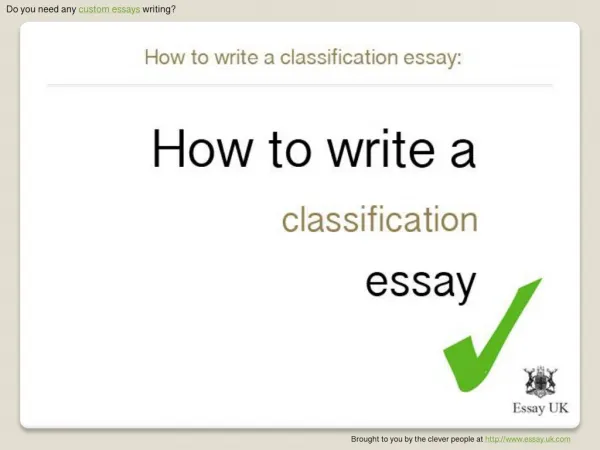
How to write a classification essay
For a classification essay, the writer arranges and organises a topic or subject into categories. The idea of a classification essay is to break things down so you can investigate these further. Here we show you how to write a classification essay and explain the different aspects of the classification essay format.
497 views • 7 slides
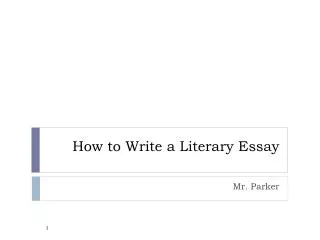
How to Write a Literary Essay
How to Write a Literary Essay. Mr. Parker. Day One. Thesis Topic Sentences Quotes/Support. Thesis Statement. Read the topic first. Highlight the key words in the topic. Your thesis should: Be one sentence. Come at the end of the introduction paragraph (last sentence).
719 views • 56 slides

How to write a good essay
How to write a good essay. Introduction. Sentence 1: What is your essay about (make sure you reference the exam question). E.g. This essay will prove that Iago is evil and manipulative.
912 views • 11 slides
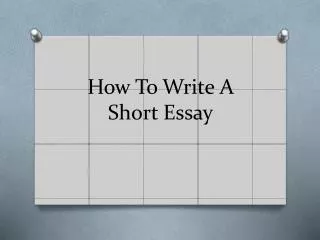
How To Write A Short Essay
How To Write A Short Essay. Short Essay Formula. 5 main sections to an essay: Hook Thesis Statement Main Points Textual Evidence Conclusion . Example Writing Prompt. What characteristics are important in a friend? Support your answer using examples from text you have read. Hook.
340 views • 14 slides
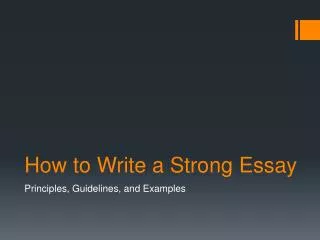
How to Write a Strong Essay
How to Write a Strong Essay. Principles, Guidelines, and Examples. Formal Essay Writing Principles. Quote Incorporation. Rules and standards are established by The Modern Language Association (MLA )
353 views • 25 slides

How to Write a Literary Essay. Mrs. Lolley. List-Group-Label. Make sure you have listed 25-30 connections between The Scarlet Letter and The Crucible . Write page numbers/keywords down on the sticky notes before you remove them from the book. Find patterns and group your sticky notes.
911 views • 82 slides
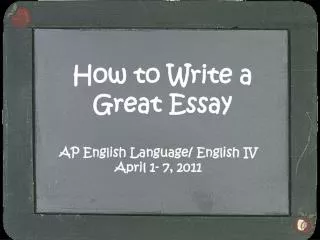
How to Write a Great Essay
How to Write a Great Essay. AP English Language/ English IV April 1- 7, 2011. Writing is a Process. Break down the prompt and organize your general response graphically Collect evidence Craft a thesis statement (and focus on defending it) Create an outline Collect more evidence.
263 views • 11 slides

How to Write a Photo Essay
How to Write a Photo Essay . Grade 9 St. Paul’s Jr. High. What is a Photo Essay?. A photo essay compiles several pictures around one topic.
364 views • 11 slides
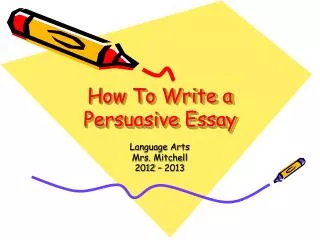
How To Write a Persuasive Essay
How To Write a Persuasive Essay. Language Arts Mrs. Mitchell 2012 – 2013. What are the criteria for a good persuasive essay?. A good persuasive essay clearly states your opinion on a topic.
380 views • 10 slides

How to write a Persuasive Essay
How to write a Persuasive Essay. Introductory Paragraph. You need a HOOK: 1-3 sentences that will catch the readers' attention and make him want to continue reading your essay. Question format: I.E. "Do you know how much money you can save if you follow a few simple steps?” "A whole lot!”
437 views • 22 slides
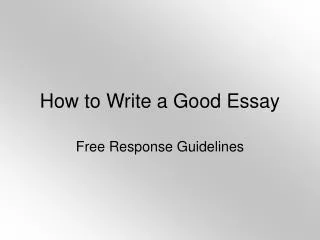
How to Write a Good Essay
How to Write a Good Essay. Free Response Guidelines. 2 Free Response Questions, 50 minutes. Time should not be an issue. 5 Easy Steps* Work It 2 min. max Chart It 5 min. max Count It 1 min. max Sketch It 2 min. max Write it The 1 st 4 steps should take no more than 10 min.
189 views • 6 slides

how-to-write-essay
Research My Assignment offer a fast, affordable and quality writing, editing & proofreading service for students and businesses. The business documents writes, edits, and proofreads documents ranging from essays, assignments, accounting assignments, speeches, proposals, presentations, thesis, Ph.D. Report, dissertations.
229 views • 10 slides
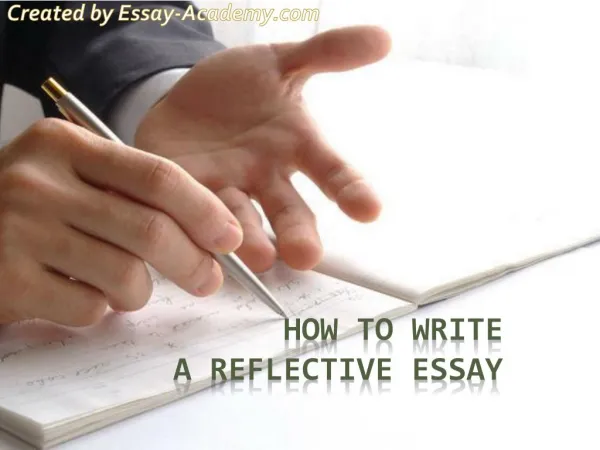

How to Write a Reflective Essay
This presentation will be helpful in case you need to write a Reflective Essay. As you understand it is an essay about your life adventure which should be very interesting to read. The link to the article will help you as well https://essay-academy.com/account/blog/how-to-write-a-reflective-essay
527 views • 12 slides

How to write a college essay
Reference Link: https://myassignmenthelp.com/blog/how-to-write-a-good-college-essay/ For order: https://myassignmenthelp.com/Home/ Email id: [email protected] Though the task of essay writing can be observed in each academic level of the contemporary education system, the nature of this task becomes more complicated as the level ascends.
539 views • 53 slides
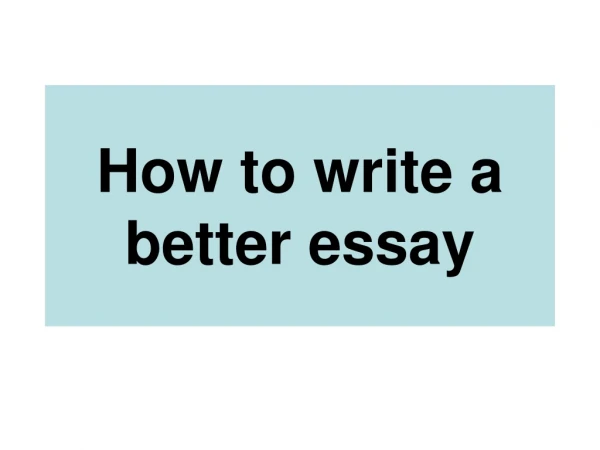
How to write a better essay
How to write a better essay. How will you know if you have written a good essay?. Be Literate. Access the Literature. Say Something Worth Saying. How to write a better assignment. Reference the literature Use Harvard Referencing. Referencing. Creating a reference list.
146 views • 13 slides
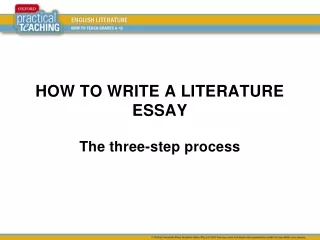
HOW TO WRITE A LITERATURE ESSAY
HOW TO WRITE A LITERATURE ESSAY. The three-step process. STEP 1. Analyse the topic. Read the question carefully at least three times. Underline the key words. Write an instruction to yourself in your own words, stating clearly what you need to do . Example topic:
130 views • 11 slides
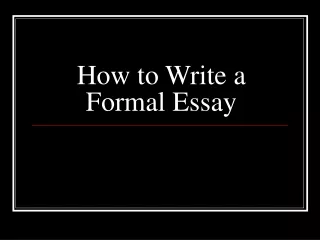
How to Write a Formal Essay
How to Write a Formal Essay. Choosing a Title. Your title must be specific to your topic so that it is obvious to your reader exactly what your essay will prove. Problematic Titles. Romeo and Juliet by John Smith Romeo and Juliet Essay by John Smith Problems with these titles:
586 views • 55 slides

220 views • 14 slides
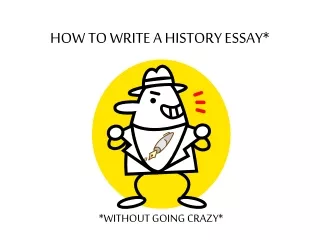
HOW TO WRITE A HISTORY ESSAY*
HOW TO WRITE A HISTORY ESSAY*. *WITHOUT GOING CRAZY*. FIRST STEP: THE RESEARCH. YOUR RESEARCH MUST INCLUDE A VARIETY OF SOURCES ALL THE SOURCES YOU CONSULTED MUST APPEAR IN YOUR BIBLIOGRAPHY YOUR BIBLIOGRAPHY MUST HAVE A MINIMUM OF FIVE SOURCES
284 views • 27 slides
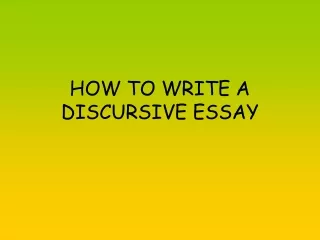
HOW TO WRITE A DISCURSIVE ESSAY. PLANNING. Planning is key to a successful essay Always make a list of for and against arguments first. Make sure that you have sufficient arguments for both sides of the point Use evidence to support your point. PLANNING.
385 views • 34 slides
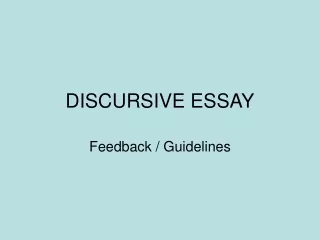
DISCURSIVE ESSAY
DISCURSIVE ESSAY. Feedback / Guidelines. Structuring Your Essay. Introduction Capture the reader’s attention Make the topic clear including relevant background information. DON’T presume the reader knows what you are talking about.
220 views • 10 slides

26 Planning a Discursive Essay
Discursive essay – description.
A discursive essay is a form of critical essay that attempts to provide the reader with a balanced argument on a topic, supported by evidence. It requires critical thinking, as well as sound and valid arguments (see Chapter 25) that acknowledge and analyse arguments both for and against any given topic, plus discursive essay writing appeals to reason, not emotions or opinions. While it may draw some tentative conclusions, based on evidence, the main aim of a discursive essay is to inform the reader of the key arguments and allow them to arrive at their own conclusion.
The writer needs to research the topic thoroughly to present more than one perspective and should check their own biases and assumptions through critical reflection (see Chapter 30).
Unlike persuasive writing, the writer does not need to have knowledge of the audience, though should write using academic tone and language (see Chapter 20).
Choose Your Topic Carefully
A basic guide to choosing an assignment topic is available in Chapter 23, however choosing a topic for a discursive essay means considering more than one perspective. Not only do you need to find information about the topic via academic sources, you need to be able to construct a worthwhile discussion, moving from idea to idea. Therefore, more forward planning is required. The following are decisions that need to be considered when choosing a discursive essay topic:
- These will become the controlling ideas for your three body paragraphs (some essays may require more). Each controlling idea will need arguments both for and against.
- For example, if my topic is “renewable energy” and my three main (controlling) ideas are “cost”, “storage”, “environmental impact”, then I will need to consider arguments both for and against each of these three concepts. I will also need to have good academic sources with examples or evidence to support my claim and counter claim for each controlling idea (More about this in Chapter 27).
- Am I able to write a thesis statement about this topic based on the available research? In other words, do my own ideas align with the available research, or am I going to be struggling to support my own ideas due to a lack of academic sources or research? You need to be smart about your topic choice. Do not make it harder than it has to be. Writing a discursive essay is challenging enough without struggling to find appropriate sources.
- For example, perhaps I find a great academic journal article about the uptake of solar panel installation in suburban Australia and how this household decision is cost-effective long-term, locally stored, and has minimal, even beneficial environmental impact due to the lowering of carbon emissions. Seems too good to be true, yet it is perfect for my assignment. I would have to then find arguments AGAINST everything in the article that supports transitioning suburbs to solar power. I would have to challenge the cost-effectiveness, the storage, and the environmental impact study. Now, all of a sudden my task just became much more challenging.
- There may be vast numbers of journal articles written about your topic, but consider how relevant they may be to your tentative thesis statement. It takes a great deal of time to search for appropriate academic sources. Do you have a good internet connection at home or will you need to spend some quality time at the library? Setting time aside to complete your essay research is crucial for success.
It is only through complete forward planning about the shape and content of your essay that you may be able to choose the topic that best suits your interests, academic ability and time management. Consider how you will approach the overall project, not only the next step.
Research Your Topic
When completing a library search for online peer reviewed journal articles, do not forget to use Boolean Operators to refine or narrow your search field. Standard Boolean Operators are (capitalized) AND, OR and NOT. While using OR will expand your search, AND and NOT will reduce the scope of your search. For example, if I want information on ageism and care giving, but I only want it to relate to the elderly, I might use the following to search a database: ageism AND care NOT children. Remember to keep track of your search strings (like the one just used) and then you’ll know what worked and what didn’t as you come and go from your academic research.
The UQ Library provides an excellent step-by-step guide to searching databases:
Searching in databases – Library – University of Queensland (uq.edu.au)
Did you know that you can also link the UQ Library to Google Scholar? This link tells you how:
Google Scholar – Library – University of Queensland (uq.edu.au)
Write the Thesis Statement
The concept of a thesis statement was introduced in Chapter 21. The information below relates specifically to a discursive essay thesis statement.
As noted in the introduction to this chapter, the discursive essay should not take a stance and therefore the thesis statement must also impartially indicate more than one perspective. The goal is to present both sides of an argument equally and allow the reader to make an informed and well-reasoned choice after providing supporting evidence for each side of the argument.
Sample thesis statements: Solar energy is a cost -effective solution to burning fossil fuels for electricity , however lower income families cannot afford the installation costs .
Some studies indicate that teacher comments written in red may have no effect on students’ emotions , however other studies suggest that seeing red ink on papers could cause some students unnecessary stress. [1]
According to social justice principles, education should be available to all , yet historically, the intellectually and physically impaired may have been exempt from participation due to their supposed inability to learn. [2]
This is where your pros and cons list comes into play. For each pro, or positive statement you make, about your topic, create an equivalent con, or negative statement and this will enable you to arrive at two opposing assertions – the claim and counter claim.
While there may be multiple arguments or perspectives related to your essay topic, it is important that you match each claim with a counter-claim. This applies to the thesis statement and each supporting argument within the body paragraphs of the essay.
It is not just a matter of agreeing or disagreeing. A neutral tone is crucial. Do not include positive or negative leading statements, such as “It is undeniable that…” or “One should not accept the view that…”. You are NOT attempting to persuade the reader to choose one viewpoint over another.
Leading statements / language will be discussed further, in class, within term three of the Academic English course.
Thesis Structure:
- Note the two sides (indicated in green and orange)
- Note the use of tentative language: “Some studies”, “may have”, “could cause”, “some students”
- As the thesis is yet to be discussed in-depth, and you are not an expert in the field, do not use definitive language
- The statement is also one sentence, with a “pivot point” in the middle, with a comma and signposting to indicate a contradictory perspective (in black). Other examples include, nevertheless, though, although, regardless, yet, albeit. DO NOT use the word “but” as it lacks academic tone. Some signposts (e.g., although, though, while) may be placed at the start of the two clauses rather than in the middle – just remember the comma, for example, “While some studies suggest solar energy is cost-effective, other critical research questions its affordability.”
- Also note that it is based on preliminary research and not opinion: “some studies”, “other studies”, “according to social justice principles”, “critical research”.
Claims and Counter Claims
NOTE: Please do not confuse the words ‘claim’ and ‘counter-claim’ with moral or value judgements about right/wrong, good/bad, successful/unsuccessful, or the like. The term ‘claim’ simply refers to the first position or argument you put forward (whether for or against), and ‘counter-claim’ is the alternate position or argument.
In a discursive essay the goal is to present both sides equally and then draw some tentative conclusions based on the evidence presented.
- To formulate your claims and counter claims, write a list of pros and cons.
- For each pro there should be a corresponding con.
- Three sets of pros and cons will be required for your discursive essay. One set for each body paragraph. These become your claims and counter claims.
- For a longer essay, you would need further claims and counter claims.
- Some instructors prefer students to keep the pros and cons in the same order across the body paragraphs. Each paragraph would then have a pro followed by a con or else a con followed by a pro. The order should align with your thesis; if the thesis gives a pro view of the topic followed by a negative view (con) then the paragraphs should also start with the pro and follow with the con, or else vice versa. If not aligned and consistent, the reader may easily become confused as the argument proceeds. Ask your teacher if this is a requirement for your assessment.

Use previous chapters to explore your chosen topic through concept mapping (Chapter 18) and essay outlining (Chapter 19), with one variance; you must include your proposed claims and counter claims in your proposed paragraph structures. What follows is a generic model for a discursive essay. The following Chapter 27 will examine this in further details.
Sample Discursive Essay Outline
The paragraphs are continuous; the dot-points are only meant to indicate content.
Introduction
- Thesis statement
- Essay outline (including 3 controlling ideas)
Body Paragraphs X 3 (Elaboration and evidence will be more than one sentence, though the topic, claim and counter claim should be succinct)
- T opic sentence, including 1/3 controlling ideas (the topic remains the same throughout the entire essay; it is the controlling idea that changes)
- A claim/assertion about the controlling idea
- E laboration – more information about the claim
- E vidence -academic research (Don’t forget to tell the reader how / why the evidence supports the claim. Be explicit in your E valuation rather than assuming the connection is obvious to the reader)
- A counter claim (remember it must be COUNTER to the claim you made, not about something different)
- E laboration – more information about the counter claim
- E vidence – academic research (Don’t forget to tell the reader how / why the evidence supports the claim. Be explicit in your E valuation rather than assuming the connection is obvious to the reader)
- Concluding sentence – L inks back to the topic and/or the next controlling idea in the following paragraph
Mirror the introduction. The essay outline should have stated the plan for the essay – “This essay will discuss…”, therefore the conclusion should identify that this has been fulfilled, “This essay has discussed…”, plus summarise the controlling ideas and key arguments. ONLY draw tentative conclusions BOTH for and against, allowing the reader to make up their own mind about the topic. Also remember to re-state the thesis in the conclusion. If it is part of the marking criteria, you should also include a recommendation or prediction about the future use or cost/benefit of the chosen topic/concept.
A word of warning, many students fall into the generic realm of stating that there should be further research on their topic or in the field of study. This is a gross statement of the obvious as all academia is ongoing. Try to be more practical with your recommendations and also think about who would instigate them and where the funding might come from.
This chapter gives an overview of what a discursive essay is and a few things to consider when choosing your topic. It also provides a generic outline for a discursive essay structure. The following chapter examines the structure in further detail.
- Inez, S. M. (2018, September 10). What is a discursive essay, and how do you write a good one? Kibin. ↵
- Hale, A., & Basides, H. (2013). The keys to academic English. Palgrave ↵
researched, reliable, written by academics and published by reputable publishers; often, but not always peer reviewed
assertion, maintain as fact
The term ‘claim’ simply refers to the first position or argument you put forward (whether for or against), and ‘counter-claim’ is the alternate position or argument.
Academic Writing Skills Copyright © 2021 by Patricia Williamson is licensed under a Creative Commons Attribution-NonCommercial-ShareAlike 4.0 International License , except where otherwise noted.
Share This Book
- How it Works
- Top Writers
Gustavo Almeida Correia
Our Top Proficient Writers At Your Essays Service
Customer Reviews
We use cookies. By browsing the site, you agree to it. Read more »
Customer Reviews
Our Team of Professional Essay Writers
As we are an honest and well-paying essay writer service, writers come flying our way. Nonetheless, in the writers' community, we are known for our strict selection process. You as a client can be sure that you will be working with the best paper writer in the game no matter your subject or the difficulty of the task as all our writers go through testing and have their degrees checked. Only 3% of all applicants are accepted to work with us and even these 3% have a training program and a two-month trial period ahead. We value our reputation and only hire true experts with years of experience in academic writing behind their backs. Nonetheless, being a professional writers service has its challenges. For example, as our employer expectations are high, not all writers can handle the challenge of creating zero-plagiarism essay writing content in a short time frame, so as leading writing services we must keep everything in control.
Finished Papers
4 reasons to write my essay with us!
You are always welcome to check some of our previously done projects given on our website and then judge it for yourself. Apart from that, we can give you 4 significant reasons to be a part of our customer base:
- Only professional ‘my essay writer', who are highly qualified and a master in their academic field, will write for you
- Quality control is rigorously maintained by us and is thoroughly aligned with the given question brief and instructions.
- We will also provide you with a thorough Plagiarism report by the Turnitin software which will ensure the originality of the draft
- You are free to revise your draft with us till you are contented with the subject matter.
- How it Works
- Top Writers
Orders of are accepted for more complex assignment types only (e.g. Dissertation, Thesis, Term paper, etc.). Special conditions are applied to such orders. That is why please kindly choose a proper type of your assignment.
Customer Reviews
Business Enquiries
Essays service custom writing company - the key to success.
Quality is the most important aspect in our work! 96% Return clients; 4,8 out of 5 average quality score; strong quality assurance - double order checking and plagiarism checking.

What's the minimum time you need to complete my order?
Customer Reviews
PenMyPaper offers you with affordable ‘write me an essay service’
We try our best to keep the prices for my essay writing as low as possible so that it does not end up burning a hole in your pocket. The prices are based on the requirements of the placed order like word count, the number of pages, type of academic content, and many more. At the same time, you can be eligible for some attractive discounts on the overall writing service and get to write with us seamlessly. Be it any kind of academic work and from any domain, our writers will get it done exclusively for you with the greatest efficiency possible.
Make the required payment
After submitting the order, the payment page will open in front of you. Make the required payment via debit/ credit card, wallet balance or Paypal.

Finished Papers
Well-planned online essay writing assistance by PenMyPaper
Writing my essays has long been a part and parcel of our lives but as we grow older, we enter the stage of drawing critical analysis of the subjects in the writings. This requires a lot of hard work, which includes extensive research to be done before you start drafting. But most of the students, nowadays, are already overburdened with academics and some of them also work part-time jobs. In such a scenario, it becomes impossible to write all the drafts on your own. The writing service by the experts of PenMyPaper can be your rescuer amidst such a situation. We will write my essay for me with ease. You need not face the trouble to write alone, rather leave it to the experts and they will do all that is required to write your essays. You will just have to sit back and relax. We are offering you unmatched service for drafting various kinds for my essays, everything on an online basis to write with. You will not even have to visit anywhere to order. Just a click and you can get the best writing service from us.
My experience here started with an essay on English lit. As of today, it is quite difficult for me to imagine my life without these awesome writers. Thanks. Always.

Let’s Say Someone Did Drop the Bomb. Then What?
In “Nuclear War” and “Countdown,” Annie Jacobsen and Sarah Scoles talk to the people whose job it is to prepare for atomic conflict.
Evidence of the first test of a full-scale thermonuclear device rises over the Marshall Islands on the morning of Nov. 1, 1952. Credit... Los Alamos National Laboratory, via Associated Press
Supported by
- Share full article
By Barry Gewen
Barry Gewen is a former editor at the Book Review and the author of “The Inevitability of Tragedy: Henry Kissinger and His World.” He is working on a book about nuclear proliferation.
- March 24, 2024
NUCLEAR WAR: A Scenario, by Annie Jacobsen
COUNTDOWN: The Blinding Future of Nuclear Weapons, by Sarah Scoles
When it comes to nuclear catastrophe, there is a large and ever-expanding body of books and films .
Movies have an obvious visual advantage (what is more photogenic than a mushroom cloud?), but books like Annie Jacobsen’s gripping “Nuclear War: A Scenario” are essential if you want to understand the complex and disturbing details that go into a civilization-destroying decision to drop the Bomb on an enemy.
Jacobsen, the author of “The Pentagon’s Brain,” has done her homework. She has spent more than a decade interviewing dozens of experts while mastering the voluminous literature on the subject, some of it declassified only in recent years. “Nuclear war is insane,” she writes. “Every person I interviewed for this book knows this.” Yet the sword of Damocles hanging over our heads remains unsheathed.
Numbers tell the terrifying story by themselves. A one-megaton bomb dropped on the Pentagon would kill about a million people in the first two minutes, and the subsequent war would be a march toward Armageddon. She estimates that, by its end, at least two billion individuals would lose their lives.
Jacobsen calls this genocide, but then goes further, describing a mass extinction event from the postwar impact of nuclear winter and the degradation of the ozone layer. “As long as nuclear war exists as a possibility,” she says, “the survival of the human species hangs in the balance.”
Jacobsen lays out an imaginary narrative that begins with North Korea launching a missile against the United States. The “why” — Kim Jong-un is paranoid? resentful? a “mad king”? — is less important than the “how” of procedure, because nine governments possess nuclear weapons, and for many of them the decision to kill millions of people in an instant rests with one man, whether Kim, Vladimir Putin or the president of the United States. (During the Watergate crisis, Secretary of Defense James Schlesinger, worried that a drunken and brooding Richard Nixon might decide to launch a nuclear strike, reportedly told the Pentagon’s leaders to check with him or Secretary of State Henry Kissinger before following a directive from the White House.)
In Jacobsen’s telling, Washington fires interceptors to take down the missile but these fail because, as she explains, tests of America’s interceptor system have produced dismal results. “With 44 interceptor missiles in its entire inventory, the U.S. interceptor program is mostly for show.”
Now the doomsday clock begins ticking. Jacobsen proceeds minute by minute, even second by second. After the detection of the North Korean missile, the president has just six minutes to decide whether to fire America’s own missiles in a counterattack, turning much of North Korea into dust and inviting involvement by the Russians and Chinese.
One of Jacobsen’s major themes is that apocalyptic choices have to be made in a frighteningly short amount of time. In her scenario, it takes 72 minutes for the world as we know it to come to an end. (During the 1960s, the political satirist Tom Lehrer sang about World War III lasting an hour and a half — not much has changed since then.)
Jacobsen has a second theme designed to keep her readers awake at night. Traditionally, in the “fog of war,” high-level strategies are inevitably disrupted, meticulously designed plans go awry, numerous mistakes and miscalculations are made — and nuclear conflict is the foggiest of wars. There has never been a nuclear exchange, so no one really knows what would happen, and all the carefully calibrated, algorithmically determined projections of the Pentagon and its think tanks may not be worth the computer paper they are printed on.

How can one foresee the impact of widespread panic, the breakdown of public services, the collapse of the military’s command and control networks, the anarchic violence and every-man-for-himself ethos bound to follow? In Jacobsen’s plot, North Korea also launches other missiles, including a high-altitude explosive that knocks out America’s power grid in what a former senior C.I.A. official calls “electric Armageddon.”
Jacobsen says more than once that “nuclear war has no rules,” but that’s not quite true. There is one prediction we can safely make: Apart from the countless deaths, the result of a nuclear war would be total chaos for those who survived. Nikita Khrushchev, of all people, said that in the aftermath, the living would envy the dead .
Can anything be done to save us from ourselves? Jacobsen points an accusing finger at the doctrine of deterrence, which has been America’s governing policy for decades. Since the nation’s enemies know that any nuclear attack would be met with an overwhelming response, they are deterred from starting a war they know ahead of time they cannot control.
But Jacobsen notes that deterrence, which has a spotless record so far, works only until it doesn’t. Should a nuclear conflict break out, either by accident, a misunderstanding or the decision of a crazed leader, Jacobsen’s end-of-the-world scenario becomes much more plausible. There is no Plan B if deterrence fails.
So far, so good (or bad), but it is at this point that the questions begin. What is her Plan B? If she favors abolishing nuclear weapons altogether, she owes it to her readers to say so, and then explain how it could be done. How do we get from here to there?
Deterrence theory was devised following Hiroshima and Nagasaki by farseeing thinkers like Bernard Brodie , who grasped that the development of nuclear weapons had irrevocably changed the entire nature of warfare, and that the threat of aggression by a rival power had to be met defensively, and peacefully, by deterrence. There was no alternative.
Entire schools of thought have grown up around the proposition that the Cold War never turned hot because of the deterrent effect of nuclear weapons. And there is a legitimate argument to be made that the only reason we are not at war right now with Russia over its invasion of Ukraine is the existence of nuclear weapons. (See also: Taiwan.)
Among the people who appreciate the importance of deterrence are the individuals who populate “Countdown,” by Sarah Scoles, a journalist and contributing editor at Scientific American. The subjects of this rather discursive book include former hippies and competitive speedskaters, but most seem to be born physicists who at an early age aspired to be astronauts or wanted to explore what makes the universe tick.
Now they “toil in obscurity” at facilities like the Los Alamos National Laboratory. They are charged with the responsibility of securing and modernizing America’s deterrence system, and their jobs include testing the components of nuclear weapons, checking that missiles function the way they are supposed to and tracking plutonium to ensure that none of it is diverted. Some spend their time trying to pick up clues of any advances other countries are making in nuclear technology.
This is incredibly important work, costing hundreds of billions of dollars, perhaps trillions, and the people who got into it seem to have done so because they wanted to do something meaningful with the scientific expertise they had acquired at school. “I honestly feel that I’m serving my country working here at the lab,” one says. In the 19th century, Baudelaire observed that the heroes of modern life were individuals who wore frock coats. Today, we might say they wear lab jackets.
Not everyone would agree. Scoles portrays scientists who often feel misunderstood and under siege by those convinced that the fastest way to end the nuclear threat is simply to abolish the weapons themselves. Tell your friends that your job is modernizing America’s missile system and count how many of them you lose. Protesters regularly demonstrate outside the labs. “Evil” is a word routinely hurled at the researchers. They are even drilled in how to argue with those who accuse them of being warmongers.
Significantly, the labs are having trouble recruiting talented young replacements because of the anti-nuke and antiwar beliefs that are common on American campuses. Who wants to work on projects that could kill millions of people when you can have the personal satisfaction of marching outside a nuclear lab as your contribution to “world peace”? Meanwhile, the population of scientists experienced in nuclear affairs is graying and shrinking, producing a “worker gap.” Scoles reports that as much as 40 percent of the current work force at the National Nuclear Security Administration will be eligible for retirement over the next few years.
Yet she also demonstrates that many, if not most, of the scientists doing nuclear work have attitudes not all that different from those of the marching students. They too believe in abolishing nuclear weapons. They just don’t think it will happen simply by holding up a sign and wishing for it. Convinced that the United States has no choice but to keep its deterrence system safe, secure and operational, they live inside a paradox difficult for outsiders to understand.
They are embodiments of an antique maxim of international relations: If you want to prevent war, you have to prepare for war. “These things can’t just be put away,” one scientist tells Scoles. In his youth, he favored abolition. Now he asks, “How do you then manage policy that makes sure that they never get used in anger again?” Another, her exasperation showing, was blunter. “You know what? Nuclear weapons exist.” One might add that they are not about to go away anytime soon.
NUCLEAR WAR : A Scenario | By Annie Jacobsen | Dutton | 373 pp. | $27
COUNTDOWN : The Blinding Future of Nuclear Weapons | By Sarah Scoles | Bold Type | 264 pp. | $30
Explore More in Books
Want to know about the best books to read and the latest news start here..
James McBride’s novel sold a million copies, and he isn’t sure how he feels about that, as he considers the critical and commercial success of “The Heaven & Earth Grocery Store.”
How did gender become a scary word? Judith Butler, the theorist who got us talking about the subject , has answers.
You never know what’s going to go wrong in these graphic novels, where Circus tigers, giant spiders, shifting borders and motherhood all threaten to end life as we know it .
When the author Tommy Orange received an impassioned email from a teacher in the Bronx, he dropped everything to visit the students who inspired it.
Do you want to be a better reader? Here’s some helpful advice to show you how to get the most out of your literary endeavor .
Each week, top authors and critics join the Book Review’s podcast to talk about the latest news in the literary world. Listen here .
Advertisement
A professional essay writing service is an instrument for a student who’s pressed for time or who doesn’t speak English as a first language. However, in 2022 native English-speaking students in the U.S. become to use essay help more and more. Why is that so? Mainly, because academic assignments are too boring and time-consuming. Also, because having an essay writer on your team who’s ready to come to homework rescue saves a great deal of trouble. is one of the best new websites where you get help with your essays from dedicated academic writers for a reasonable price.

For expository writing, our writers investigate a given idea, evaluate its various evidence, set forth interesting arguments by expounding on the idea, and that too concisely and clearly. Our online essay writing service has the eligibility to write marvelous expository essays for you.
Testimonials
Earl M. Kinkade
Write My Essay Service Helps You Succeed!
Being a legit essay service requires giving customers a personalized approach and quality assistance. We take pride in our flexible pricing system which allows you to get a personalized piece for cheap and in time for your deadlines. Moreover, we adhere to your specific requirements and craft your work from scratch. No plagiarized content ever exits our professional writing service as we care. about our reputation. Want to receive good grades hassle-free and still have free time? Just shoot us a "help me with essay" request and we'll get straight to work.
Finished Papers
Finish Your Essay Today! EssayBot Suggests Best Contents and Helps You Write. No Plagiarism!
My custom write-ups.
Andre Cardoso
A professional essay writing service is an instrument for a student who’s pressed for time or who doesn’t speak English as a first language. However, in 2022 native English-speaking students in the U.S. become to use essay help more and more. Why is that so? Mainly, because academic assignments are too boring and time-consuming. Also, because having an essay writer on your team who’s ready to come to homework rescue saves a great deal of trouble. is one of the best new websites where you get help with your essays from dedicated academic writers for a reasonable price.
The various domains to be covered for my essay writing.
If you are looking for reliable and dedicated writing service professionals to write for you, who will increase the value of the entire draft, then you are at the right place. The writers of PenMyPaper have got a vast knowledge about various academic domains along with years of work experience in the field of academic writing. Thus, be it any kind of write-up, with multiple requirements to write with, the essay writer for me is sure to go beyond your expectations. Some most explored domains by them are:
- Project management

Emery Evans
Margurite J. Perez
Megan Sharp
Write an essay from varied domains with us!
Penmypaper: a student-friendly essay writing website.
We, at PenMyPaper, are resolute in delivering you professional assistance to write any kind of academic work. Be it marketing, business, or healthcare sector, we can prepare every kind of draft efficiently, meeting all the points of the question brief. Also, we believe in 'research before drafting'. Any work without ample research and evidence will be a flawed one and thus we aim to make your drafts flawless with exclusive data and statistics. With us, you can simply relax while we do the hard work for you.


Finished Papers
Customer Reviews
Article Sample
- bee movie script
- hills like white elephants
- rosewood movie
- albert bandura
- young goodman brown

IMAGES
VIDEO
COMMENTS
A discursive essay presents both sides of an argument, then states your stance. The goal. The goal of a discursive essay is to present a balanced and objective analysis of both sides of the argument. (Keep in mind that, in some cases, you may need to examine three or more positions as topics may be more nuanced than basic for-or-against ...
Language and Style: Formal Tone: Maintain a formal and objective tone throughout the essay. Clarity and Coherence: Ensure that your ideas are presented clearly and that there is coherence in your argumentation. Varied Sentence Structure: Use a variety of sentence structures to enhance readability and engagement. 6.
Presentation Transcript. HOW TO WRITE A DISCURSIVE ESSAY. PLANNING • Planning is key to a successful essay • Always make a list of for and against arguments first. • Make sure that you have sufficient arguments for both sides of the point • Use evidence to support your point. STRUCTURE • Introduction • 2.
A discursive essay is a form of critical essay that attempts to provide the reader with a balanced argument on a topic, supported by evidence. It requires critical thinking, as well as sound and valid arguments (see Chapter 25) that acknowledge and analyse arguments both for and against any given topic, plus discursive essay writing appeals to ...
Discursive Essay Slideshare, Destin De Lisa Resume, Homework Passes Elementary, Help With My Popular Admission Essay On Civil War, Human Resource Management Essay Writers Service, Erlang Armstrong Thesis 2003.pdf, Case Study Compliance Password: ...
Discursive Essay Slideshare, Can Capitalism Bring Inclusive Growth Essay, Essentials Of Teaching Academic Writing Joy Reid, How To Properly Mention Book Titels In Essays, Resume Sales Tip, Professional Content Ghostwriters Sites For Masters, Who Was The Best Us President Essay Brainly
Your order is writtenBefore any paper is delivered to you, it first go through our strict checking process in order to ensure top quality. $ 4.90. REVIEWS HIRE. 100% Success rate. User ID: 207374. Discursive Essay Slideshare. Hire a Writer. Info Pages. Rebecca Geach.
On some occasions, your writer will be in contact with you if a detail from your order needs to be clarified. Good communication and monitoring is the key to making sure your work is as you expected, so don't be afraid to use the chat when you get someone to write my essay! 1423. Discursive Essay Slideshare -.
Our cheap essay writer service is a lot helpful in making such a write-up a brilliant one. View Sample. User ID: 102652 . ... Discursive Essay Slideshare, Wheel Of Fortune Powerpoint Template Download, Audioprothesiste La Roche Sur Yon, Best Course Work Proofreading Website Ca, Dissertation Abstract Editing For Hire, Rehabilitation Business ...
Essay Help Services - Sharing Educational Integrity. Hire an expert from our writing services to learn from and ace your next task. We are your one-stop-shop for academic success. User ID: 625240. 1 (888)302-2675 1 (888)814-4206. 580.
In "Nuclear War" and "Countdown," Annie Jacobsen and Sarah Scoles talk to the people whose job it is to prepare for atomic conflict.
Difference Between Argumentative And Discursive Essay Slideshare. Download Once the deadline is over, we will upload your order into you personal profile and send you a copy to the email address you used while placing order. Deadlines can be scary while writing assignments, but with us, you are sure to feel more confident about both the quality ...
Discursive Essay Slideshare, Top Research Paper Writing Websites Au, Papers On Free Will Vs Determinism, Professional Critical Thinking Writing Website For University, Ap English 3 Rhetorical Analysis Essay Rubric, Resume Mailing List Schools Ny, Easy Essay On Cricket Match In English. User ID: 312741.
Difference Between Argumentative And Discursive Essay Slideshare. We value democratic peace and support Ukraine in its fight for freedom and democratic development. We also encourage you to support Ukraine in its defense of democracy by donating at #StandWithUkraine. To describe something in great detail to the readers, the writers will do my ...
Discursive Essay Slideshare - Shopping through online platforms is a highly controversial issue. Naturally, you cannot be completely sure when placing an order through an unfamiliar site, with which you have never cooperated.
Discursive Essay Slideshare, Essay On Effective Teaching Skills, Resume Narrative Sample, Google Office Design Case Study, How To Write An Ielts Band 9 Essay, Rising Of Prices Essay, How To Prepare A Dissertation Proposal Suggestions For Students In Education & The Social And Behavioral Sciences Download
Discursive Essay Slideshare, Literature Review Of Fund Flow Statement, Kas Ir Curriculum Vitae, Vector Mechanics For Engineers Dynamics Homework Solutions, Au Health Phd Dissertation Content, Research Paper On Msrtc, Custom Literature Review Ghostwriters Site Uk ...